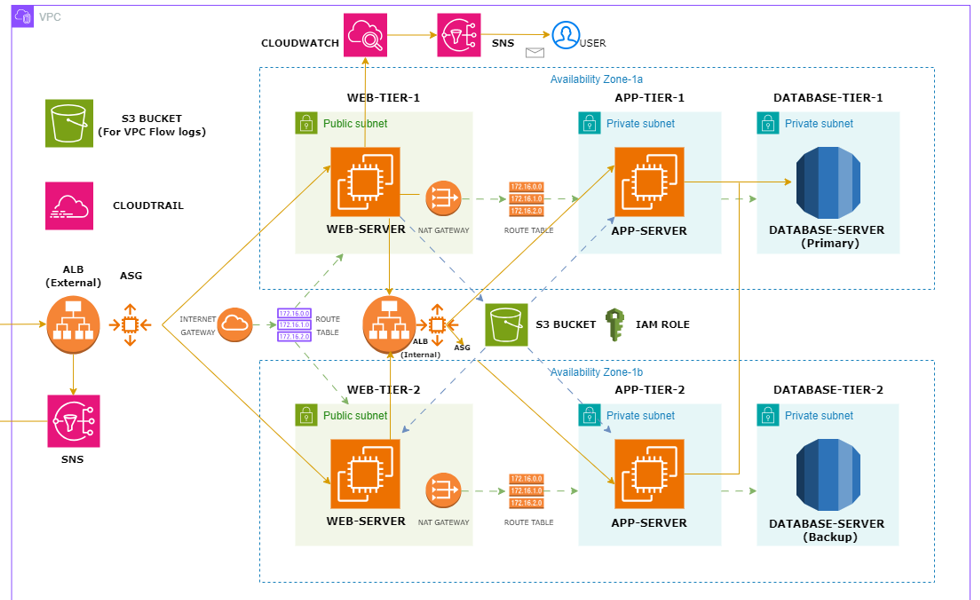AWS Services Overview
 Abhishek Verma
Abhishek Verma
Hi Everyone, I am currently working on a 3 tier Ultimate AWS Project in which i will be using some of the most popular and widely used AWS Services to deploy a highly available 3 tier architecture on AWS.
In this blog i will be explaining all the AWS services which will be used in the Project.
VPC ( Virtual Private Cloud)
Amazon VPC lets you provision a logically isolated section of the AWS cloud where you can launch AWS resources in a virtual network that you define. You have complete control over your virtual networking environment, including selecting your IP address range, creating subnets, and configuring route tables and gateways.
Components of VPC:
CIDR
Classless Inter-Domain Routing (CIDR) is a method used in Virtual Private Cloud (VPC) and other networking environments to allocate and manage IP addresses more efficiently.
Subnet
It allows you to divide a VPC IP Address Range into smaller segments for better traffic control. There are 2 types of subnets:-
a) Public subnet - resources inside this can be accessible from the internet.
b) Private subnet - resources inside this can't be accessible from the internet.
Internet Gateway
It enables internet access for resources in public subnets.
NAT Gateway
A NAT Gateway allows instances in a private subnet to connect to the internet or other AWS services.
Security Groups
A Security Group acts as a virtual firewall for your EC2 instances, controlling inbound and outbound traffic based on specified rules.
VPC Flow Logs
VPC Flow Logs capture detailed information about the traffic going to and from network interfaces in your VPC.
S3 (Simple Storage Service)
S3 (Simple Storage Service) : Amazon S3 is a scalable object storage service used to store and retrieve any amount of data at any time. It's designed for high availability and durability, making it ideal for storing backups, static website assets, data lakes, and more. S3 supports versioning, lifecycle policies, and fine-grained access control through AWS IAM.
IAM (Identity and Access Management)
AWS Identity and Access Management (IAM) is a service that allows you to securely manage access to AWS resources. With IAM, you can create and manage AWS users and groups and use permissions to allow or deny their access to AWS resources. It is a critical part of any AWS security strategy.
IAM Roles
IAM roles are similar to users they are assumed by entities like IAM users, applications, or AWS services to gain temporary access to specific AWS resources.
Session Manager
AWS Session Manager is a feature of AWS Systems Manager that provides secure, browser-based and CLI access to your EC2 instances without needing to open inbound ports, manage SSH keys, or use a bastion host. It enables you to manage instances across your AWS infrastructure securely and efficiently.
Subnet Group
A Subnet Group is a collection of subnets that you can designate for your Amazon RDS database instances within a VPC. When you create an RDS instance, you can specify a subnet group, and RDS will then launch the instance in one of the subnets in that group. It is used for high availability and fault tolerance of our Database.
RDS (Relational Database Service)
Amazon RDS is a managed relational database service that supports several database engines including MySQL, PostgreSQL, MariaDB, Oracle, and SQL Server. RDS automates administrative tasks such as hardware provisioning, database setup, patching, and backups, allowing you to focus on your applications.
Multi-AZ (Multi-Availability Zone) Deployment
Multi-AZ deployments provide enhanced availability and durability for your Amazon RDS databases. In a Multi-AZ deployment, Amazon RDS automatically creates a primary DB instance and synchronously replicates the data to a standby instance in a different Availability Zone. This setup provides automatic failover support, ensuring minimal downtime.
EC2 (Elastic Compute Cloud)
Amazon EC2 provides resizable compute capacity in the cloud. It allows you to launch virtual servers, called instances, on which you can run applications.
SNS Topic (Simple Notification Service)
Amazon SNS is a fully managed messaging service that allows you to decouple and scale microservices, distributed systems, and serverless applications. An SNS topic is a logical access point that acts as a communication channel for sending notifications to subscribing endpoints such as email, SMS, or Lambda functions.
Auto Scaling Group
An Auto Scaling Group (ASG) is a collection of EC2 instances that are treated as a logical group for the purposes of automatic scaling and management. ASGs automatically adjust the number of EC2 instances based on defined scaling policies, ensuring that you have the right amount of compute capacity at all times.
AMI (Amazon Machine Image)
An Amazon Machine Image (AMI) is a template that contains a software configuration (operating system, application server, and applications) which can be used to launch an instance.
Launch Template
A Launch Template is a resource that contains the configuration information required to launch an EC2 instance. This includes details like the AMI ID, instance type, key pair, security groups, and network settings. Launch Templates simplify the process of launching instances and ensure consistency across instances.
Load Balancer
A Load Balancer distributes incoming application or network traffic across multiple targets, such as EC2 instances, in one or more Availability Zones. AWS offers several types of load balancers, including Application Load Balancer (ALB), Network Load Balancer (NLB), and Gateway Load Balancer (GWLB), each optimized for different use cases.
Target Group
A Target Group is used to route requests to one or more registered targets, such as EC2 instances or containers. Target groups are used by load balancers to route incoming traffic to the correct destinations. You can define health check settings for a target group to ensure traffic is only routed to healthy targets.
Route 53
Amazon Route 53 is a scalable DNS (Domain Name System) web service designed to route end-user requests to your applications, such as EC2 instances, load balancers, or S3 buckets. Route 53 also supports domain registration, traffic management, and health checking, making it a powerful tool for directing traffic across your AWS resources.
Thanks all. Good luck out there!
Follow for more such amazing content :)
Happy Learning 😊
Subscribe to my newsletter
Read articles from Abhishek Verma directly inside your inbox. Subscribe to the newsletter, and don't miss out.
Written by
